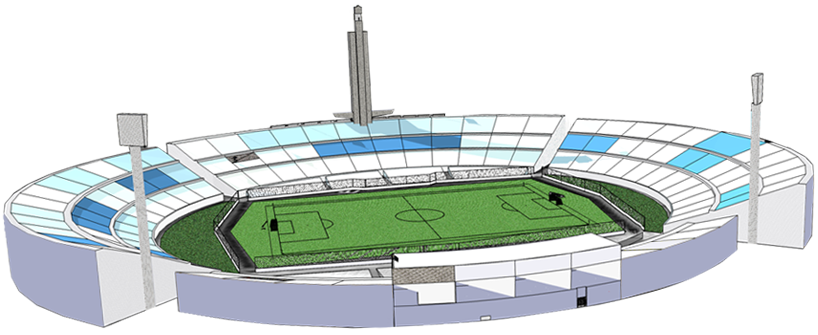Institutional
History of the Centenario Stadium
The Centenario Stadium is where the final of the first FIFA World Cup was played in 1930, coinciding with its inauguration year.
This historic venue was declared a Historic Monument of World Football by FIFA on July 18, 1983, making it the only construction of its kind in the world to hold such a title.
It is managed by the Administrative Commission of the Official Field (CAFO), which includes representatives from the Uruguayan Football Association (AUF) and the Municipality of Montevideo.
Its History:
With the aim of hosting the 1930 FIFA World Cup in Uruguay, the process of creating a central stadium to host all the tournament's matches began.
On July 21 of the previous year, the cornerstone of the future stadium was laid. In six months, between February and July of 1930, the work designed by architect Juan Antonio Scasso (1892-1973) was completed.
160,000 cubic meters of earth were excavated, and 14,000 cubic meters of reinforced concrete were used. 200,000 squares of turf were laid on the pitch.
According to chronicles, the floor was dried the day before the inauguration with braziers and electric stoves, and on the day of the inauguration, the cement was still fresh.
But the day of its inauguration arrived, and on July 18, a national holiday commemorating the Oath of the Constitution, the Uruguayan national team emerged victorious in their first World Cup match (1-0 against Peru).
On July 18, 1983, it was declared by FIFA as a Historic Monument of World Football, the only construction in the world in this category.
Facilities of the Stadium
Colombes
This section is located to the north, named in honor of the French city where the Uruguayan National Football Team won its first Olympic championship in 1924. It is commonly referred to as the "popular section" due to the large attendance it receives.
Ámsterdam
This section is located to the south, named in honor of the dutch city where the Uruguayan National Football Team won its second consecutive Olympic championship in 1928. Like Colombes, it is called the "popular section" for the same reason.
Olímpica
On the lateral side, there is the Olímpica Stand and its corresponding grandstand. Its name recalls that at the time of the stadium's construction, the Uruguayan team had recently won two consecutive Olympic championships.
América
In front of the Olímpica Stand is the América Stand, where the Official Box, VIP Boxes, and the upper press section are located. The rest of the stand is open to the general public.
Also located in the Stadium are School No. 100 beneath the Olímpica Stand and the Uruguayan Football Museum, which houses memorabilia from the most prominent moments in Uruguayan football history.
Football Museum:
The Football Museum is located beneath the Olímpica Stand of the Centenario Stadium.
The museum's objective is to preserve the football heritage and promote the history of Uruguayan, South American, and world football.
It was inaugurated on December 15, 1975, and subsequently remodeled in 2004, when a panoramic elevator was added to the Tower of Homages of the Stadium. Beneath it lies the foundation stone, placed in July 1929.
The museum building is distributed over two floors, occupying approximately 3,000 square meters. It has a permanent exhibition hall showcasing the archives of all the titles won by the Uruguayan national team.
The museum houses a collection of memorabilia from the pinnacle moments of Uruguayan football. One of the oldest pieces on display is the furniture used in 1916 by the officials of Uruguay, Argentina, Brazil, and Chile when they ratified the creation of the South American Football Confederation (Conmebol).
Additionally, there are historical objects (flags, trophies, and uniforms) from the Uruguayan teams that won gold medals in Colombes 1924 and Amsterdam 1928. There are also items from the 1930 and 1950 World Cups and belongings of captains José Nasazzi and Obdulio Varela.
The museum presents images and items related to the history of the Copa Libertadores won by Uruguayan teams and a review of local championships through historical magazines and team uniforms.
The museum offers various services such as a screening room, a themed shop, replicas, and souvenirs of Uruguayan football.
In the auditorium, visitors can view images of Uruguay's performance in the 1928 Olympic Games, the construction of the Centenario Stadium, and the 1930 World Cup.
Address: Centenario Stadium, Olympic Tribune Av. Ricaldoni.
Tel: 598 2480 1259
Opening: Monday to Friday from 10 am to 5 pm.

Find out all the news and
upcoming events.
We invite you tu subscribe!
